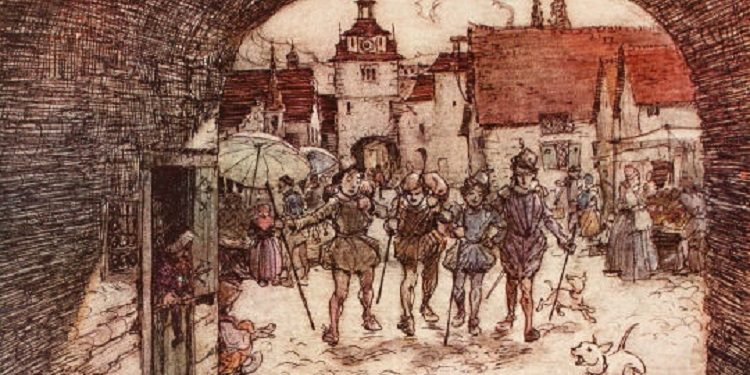The Men’s Rights Movement exists to recognize and ameliorate problems, institutional or social, that predominantly or exclusively harm boys and men. To that end, activists have adopted strategies ranging from filmmaking to legal action. Media analysis has also been done (Allemano, 2012) but with folktales largely ignored. This is unfortunate since folklore in its various forms has practical functions: entertaining, justifying institutions, enforcing cultural norms, educating, and providing escapism (Bascom, 1954). Thus, MRAs could harness the power and versatility of folktales to influence the culture. “The Four Artful Brothers” (Manheim, 1977) is a strong foundation since it complies with pro-male values in several ways.
The story tells of siblings who leave home to find jobs when they’re father is unable to provide for them. Becoming a thief, a hunter, an astronomer, and a tailor, they return home, demonstrate their skills to their approving father. A dragon attacks days later and the boys combine their talents to rescue the princess, resulting in them getting awarded their own principalities.

Folklorists have argued that this tale and its variants have remained popular partly because it focuses on educating sons (Zipes, 2000). This theme is relevant for contemporary advocates because male literacy and academic achievement lags behind that of girls (Autor & Wasserman, 2013) and has since 1870 (Tyack & Hansot, 1988). But this tale doesn’t just dramatize anxieties regarding male education, it alleviates them. “The Fourt Artful Brothers” is a multi-genre narrative that includes action, fantasy, and real-world problems, which are the kinds of texts boys prefer and which they aren’t usually given (Boys Literacy Teacher Inquiry Project, 2008). To wit: the siblings battle a dragon and survive a shipwreck, satisfying the action requirement. The presence of a dragon, an omniscient telescope, and a magical needle-and-thread place the text within fantasy. And the premise of the story – leaving home to find gainful employment – is a realistic goal and concern for many young adults. Altogether, these elements fulfill the multi-genre requirement.
Combined with that is a nuanced depiction of masculinity. For instance, the story is about young men mastering skills and courageously facing mortal peril. These two traits – mastery and courage – are considered bedrocks of traditional manhood (Donovan, 2012). Yet, the tale is inclusive of men who deviate from norms. Consider the mentors: their role as teachers is people-oriented, which contrasts with men’s general preference for object-oriented work (Rong et al., 2009). The main family also deviates from norms; the boys have no mother, implying that childrearing and housekeeping were done by their father and themselves since the birth of the youngest. The youngest himself does tailoring – a subset of textile work like sewing, knitting, and weaving – which has traditionally been a feminine craft (Barber, 1998). Notably, the king says that each of the brothers have an equal right to marry his daughter, metaphorically saying that all men are worthy of respect and recognition, regardless of their gender expression.
Another point in the tale’s favor is its multilayered subversion of male disposability. While the boys do endanger themselves for a woman they’ve never met, their primary motive is to prove the usefulness of their skills. Their secondary motive is economic, since they came from poverty and are unemployed at the time. Another challenge to the disposability of men comes from the king. Unlike real-world leaders who conscript men to war (Watson, 2014) or citizens who sacrifice men for women’s benefit (FeldmanHall et al., 2016), the king offers an incentive to save the princess and the boys are the only men to go her rescue.
Marina Warner, a prominent mythographer, once declared, “I decided that it was crucial not to leave the territory of the imagination to those history has taught us to recognize as dangerous” (The University of Sheffield, 2017). Hers is an attitude that men’s rights activist should embrace wholeheartedly, especially because those who pose a threat to male wellness already have a head start.
Bibliography
Allemano, P. (2012). “The bold, independent woman of today and ‘good’ men and boys in her life: A sampling of mainstream media representations.” In Miles Groth (Ed.), New male studies journal (pp. 31-51). Retrieved March 3, 2021 from http://newmalestudies.com/OJS/index.php/nms/article/view/6/1
Autor, D. H., & Wasserman, M. (2013). Wayward sons: The emerging gender gap in labor markets and education. Retrieved November 14, 2020 from http://economics.mit.edu/files/8754
Barber, E.W. (1994). Women’s work, the first 20,000 years: Women, cloth and society in early times. New York: W. W. Norton & Company.
Bascom, W. (1954). “The four functions of folklore.” In Alan Dundes (Ed.), The study of folklore (pp. 279-298). Englewood Cliffs: Prentice-Hall.
Boys Literacy Teacher Inquiry Project. (2008). Me read? And how! Ontario teachers report on how to improve boys’ literacy skills. Retrieved November 3, 2020 from http://www.edu.gov.on.ca/eng/curriculum/meread_andhow.pdf
Donovan, J. (2012). The way of men. Milwaukie: Dissonant Hum.
FeldmanHall, O., Dalgleish, T., Evans, D., Navrady, L., Tedeschi, E., Moobs, D. (2016). Moral chivalry: Gender and harm sensitivity predict costly altruism. Social psychological and personality science, 7(6), 542-551.
Manheim, R. (1983). Grimms’ tales for young and old: The complete stories. New York: Anchor Books.
Rong, S., Rounds, J., & Armstrong, P. I. (2009). Men and things, women and people: A meta-analysis of sex differences in interests. Psychological bulletin, 135(6), 859-884.
Tyack, D., & Hansot, E. (1988). Silence and policy talk: Historical puzzles about gender and education. Educational researcher, 17(3), 33-41.
University of Sheffield. (2017, May 8). Marina warner – prokhorov lecture [Video] https://www.youtube.com/watch?v=eGZxZzyPUwg
Watson, L. (2014). What a chicken you are: The shameful story of how a boy aged ten was handed a white feather and labelled a coward during the first world war. Daily Mail. Retrieved November 3, 2020 from https://www.dailymail.co.uk/news/article-2631822/What-chicken-The-shameful-story-boy-aged-TEN-handed-white-feather-labelled-coward-First-World-War.html
Zipes, J. (2000). The great fairy tale tradition: From straparola and basile to the brothers grimm. New York: W. W. Norton & Company.
Feature image: Public domain illustration by Arthur Rackham (copyrighted 1909 and renewed in 1920). From Snowdrop and Other Tales.